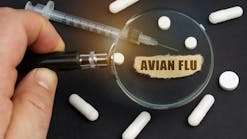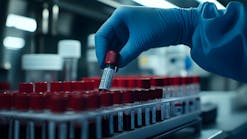Edited by Daniel M. Baer, M.D.
Water during glucose test, Retortamonas
intestinalis, occult blood developers, and amylase and lipase
Water during glucose tolerance test
Q: What is the current thinking
about allowing a patient who is undergoing a three- or four-hour glucose tolerance test to have sips of water or ice chips? We used to allow the patient to have sips of water after the first-hour blood specimen was drawn. Can the patient have small sips of water at any point during the tolerance test after the 100 grams of glucose is taken?
A: Your question begs a larger one
that challenges the usefulness of a glucose tolerance test (GTT) in the first place. In 1997, the criteria for the diagnosis of diabetes mellitus was revised to be based on a fasting (eight hour) glucose of >126mg/dL on at least two occasions. Formal GTT are no longer generally recommended. The criteria adopted by the World Health Organization and the American Diabetes Association as proposed by the National Diabetes Data Group suggest a diagnosis of diabetes mellitus be based on a two-hour post-loading dose (75 gram) blood glucose level of 200 mg/dL or more.1 However, performing an oral GTT or extending the testing of a loading-dose level beyond two hours is of decreasing diagnostic value. Likewise, the collection and testing of urine specimens concurrently with diabetic testing is out of favor. Although urine glucose levels can be of some value in diagnosing renal glycosuria, testing urine is of little value in diagnosing diabetes mellitus.
Regardless, ingesting water during a glucose tolerance test is not likely to affect the results to any significant degree, and little evidence exists that it should be restricted. Even though drinking large volumes will undoubtedly hasten the bodys metabolism of the loading dose and its excretion through the urinary tract, it is not likely to affect a diagnosis.
Dennis J. Ernst MT(ASCP)
Director
Center for Phlebotomy Education Inc.
Ramsey, IN
Reference
- Henry J., ed. Clinical diagnosis and management by laboratory methods. Philadelphia, PA:WB Saunders Co.; 2001.
Retortamonas intestinalis
Q: What is the clinical significance
of recovering Retortamonas intestinalis from urine sediment? How does it differ from Trichomonas and other parasites?
A: R. intestinalis is rarely seen in
urine sediment and is generally not clinically significant because, of the six genera of flagellates that parasitize the human intestinal or urogenital tracts, only Giardia lamblia, Dientamoeba fragilis and Trichomonas vaginalis are considered pathogens. T. vaginalis infects the urogenital tract of males and females, while the other two species reside in the intestinal tract. The other intestinal flagellates, Chilomastix mesnili, Enteromonas hominis, Trichomonas hominis (now Pentatrichomonas hominis) and R. intestinalis are all nonpathogenic commensals. With the exception of D. fragilis and Trichomonas spp., they have both trophozoite and cyst stages. The intestinal flagellates are acquired through fecal-oral transmission while T. vaginalis is transmitted through sexual contact.
T. vaginalis is recovered from vaginal and urethral discharges, prostatic secretions and urine sediment, and is seen more often in urine sediment than the other protozoan flagellates. The recovery of R. intestinalis, T. hominis or other flagellates from urine sediment usually suggest that the specimen was contaminated by fecal material and warrants careful collection of another urine specimen.
The initial differentiation of R. intestinalis from other trophozoites recovered from urine sediment is based on size and motility. R. intestinalis, Trichomonas spp., and E. hominis exhibit a jerky motility. The trophozoites of R. intestinalis and E. hominis are pear-shaped or oval and small, measuring 4 m to 10 m long by 3 m to 6 m wide. T.vaginalis and T.hominis trophozoites, on the other hand, range in size from 7 m to 23 m long by 5 m to 15 m wide, with T.hominis being slightly smaller. R.intestinalis also has a prominent cytostome, which extends half the length of the body.
David Sewell, PhD, ABMM
Director of Microbiology
Veterans Affairs Medical Center
Portland, OR
Occult blood developers
Q: I have a question regarding
substituting occult blood card developers. If the control area of one brand of card reacts properly with the developing solution of a different brand, wouldnt that indicate that the combination of card/developer is acceptable?
A: It is not a good idea to mix reagents
from different manufacturers in a test, even when they are similar (but proprietary). Although they might give acceptable control results, controls are usually set to give strong reactions, and the system could fail at a lower analyte concentration.
There is another reason why you should not do this. CLIA says that you must follow the manufacturers instructions when performing a test, or you must have experimental data showing acceptable performance characteristics for the home-brew test. That is a hard job to do. Its not a good idea to be out of compliance with CLIA.
Daniel M. Baer, MD
Professor Emeritus
Department of Pathology
Oregon Health and Science University
Portland, OR
Both amylase and lipase?
Q: We have a Beckman CX9 ALX
and are trying to decide between running lipase or pancreatic amylase. Is there a significant clinical difference between the tests? We are a 70-bed hospital. If we run lipases, that means we have to stop testing on the CX9 to clean the cuvettes and run the lipase since we run HDL, cholesterol and triglyceride. I want to give the doctors the best test available to help them make the right treatment choice. At present, we are sending lipases to our reference lab, and the turnaround time is between two to three hours, which delays the treatment for our ER patients.
A: Acute pancreatitis increased
tenfold between 1960 and 1980, and it continues to be a significant cause of death. Roughly one in 10 patients with pancreatitis die during their hospitalization. Between 60% to 80% of the cases are due to alcoholism or a gallstone obstructing the bile duct distal to the pancreatic duct.1
Amylase, lipase and other measurable digestive enzymes produced by pancreatic acini are released into the circulation instead of the digestive tract when there is pancreatic tissue injury due to pancreatic ductal obstruction or other causes of pancreatic inflammation. The clinical usefulness of the measurement of any of these enzymes is related to the ease/cost with which the test(s) can be done and the likelihood that abnormal levels will be detected when the patient presents for diagnosis.
Pancreatic amylase can be measured quite simply now, since methods of inhibiting parotid (salivary) amylase with wheat germ or, more recently, monoclonal antibody to parotid amylase have been developed. Both pancreatic amylase and lipase are measured in the typical automated chemistry analyzers by functional assays employing specific substrates. The lipase reaction is sensitive to lipolytic or esterase reagents in other assays, so, in an automated system, it requires scrupulous attention to pre-analytical factors, such as reaction chamber carryover of reagents from tests such as triglycerides or cholesterol.2
Various authors report somewhat differing timetables for the peak levels and duration of abnormality of pancreatic amylase and lipase.1,3 More current reviews tell us that the amylase will peak at 12 hours to 72 hours and will fall to normal within a week. Lipase, on the other hand, peaks in about 24 hours after onset of pain, and will remain elevated for eight to 14 days.
In a Tennessee study of 306 ER patients with acute abdominal pain, the 208 nonpancreatic cases had lower maximum enzyme levels than the 48 with acute pancreatitis. The maximum amylase level was 71 times the upper reference limit (URL), whereas the maximum lipase value was 435 times the URL.4 Another study, comparing a mass concentration assay of lipase to amylase, showed that the median increase in peak pancreatic amylase was about 14 times the upper reference limit (URL), while lipase was about 37 times the URL.5 Since patients with significant acute pancreatitis usually present to the physician or ER within a week of onset of symptoms, it appears that either test would serve to assist the physician in the diagnosis, and doing both would be redundant. Lipase has the advantage of having the greatest likelihood of being abnormal both in amplitude or duration after onset of symptoms.
Physicians are well aware that the enzyme levels may be normal in an acute attack of pancreatitis, so other assessments, both clinical and imaging, are a part of the work-up of acute abdominal pain. Ultrasound and computed tomography are fairly sensitive to demonstrate gallstone obstruction at the Ampulla of Vater or soft tissue changes indicative of edema, necrosis or microcalcifications of the pancreas. They would likely be done in all such cases, not just those in which the enzyme levels were elevated. The laboratory may sometimes document hyperproduction of amylase with increased clearance leading to a normal serum amylase by performing the Amylase/Creatinine Clearance Ratio. Immunochemical assays have been developed to measure the various protein enzymes released by pancreatitis. One of the most promising of these is a urine dipstick assay (Actim Pancreatitis) which has been designed to measure trypsinogen-2 at thresholds of detection of 50ng/mL (screening) and 2,000 ng/mL (confirmatory high-specificity assay).6
In conclusion, I would suggest that your situation justifies your present course of action with regard to the cost-complexity vs. benefit analysis. You have a reference laboratory that can support, in a respectable time frame, the occasional need for a lipase assay to help confirm a diagnosis. If you want to give the doctors the best test available, the literature leans slightly toward lipase.
Louis Buettner, MD
Consulting Pathologist
DynacareAlabama Reference Laboratories/LabSouth
Tuscaloosa, AL
References
- Munoz A & Katerndahl DA. Diagnosis and Management of Acute Pancreatitis. Am Fam Physician. 2000;62:164-74.
- Beckman-Coulter Bulletins 9157EE and 9157FF. Beckman Coulter, Inc., Brea, CA.
- Leclerc P & Forest JC. Variation in amylase isoenzymes and lipase during acute pancreatitis, and in other disorders causing hyperamylasemia. Clin Chem. 1983;29:1020-3.
- Chase CW et al. Serum Amylase and Lipase in the Evaluation of Acute Abdominal Pain. Am Surg. 1996;62:1028.
- Van Ingen HE & Sanders GT. Clinical evaluation of a pancreatic lipase mass concentration assay. Clin Chem. 1992;38:2310-3.
- Kemppainen EA et al. Rapid Measurement of Urinary Trypsinogen-2 as a Screening Test for Acute Pancreatitis. NEJM. 1997;336:1788-93.
Daniel M. Baer is professor emeritus of laboratory medicine at Oregon Health and Science University in Portland, OR, and a member of MLOs editorial advisory board.
June 2003: Vol. 35, No. 6
© 2003 Nelson Publishing, Inc. All rights reserved.







